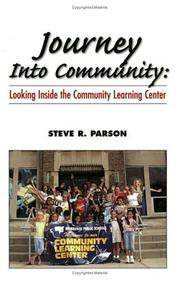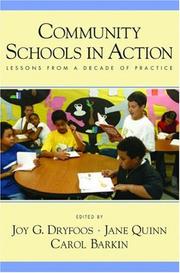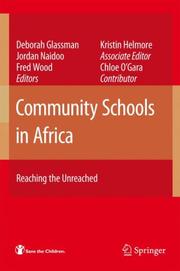| Listing 1 - 4 of 4 |
Sort by
|

ISBN: 1138432709 1315852659 1317919335 1317919343 9781317919339 129995071X 9781299950719 1930556675 9781930556676 9781315852652 9781317919322 9781138432703 Year: 2004 Publisher: London ; New York : Routledge,
Abstract | Keywords | Export | Availability | Bookmark
 Loading...
Loading...Choose an application
- Reference Manager
- EndNote
- RefWorks (Direct export to RefWorks)
This book provides a roadmap for the journey which begins when a traditional school decides to end its isolation from its community. Community Learning Centers provide teachers, administrators, parents, and community leaders with the tools they need to achieve important educational goals which include: high level student performance, after school programs which support student learning and provide enrichment activities in a safe environment, the acquisition of essential technological skills by both students and members of the community, expanding leadership opportunities for teachers, students and the community, and unlocking the storehouse of resources in the community to support the education of our youth.
Community schools --- Community and school --- School improvement programs --- Neighborhood schools --- Schools, Community --- Schools, Neighborhood --- Schools --- Urban schools --- Centralization

ISBN: 0197562175 1280534486 1423720326 0195343646 1602568510 9781423720324 9780195169591 019516959X 9781280534485 9786610534487 6610534489 9780195343649 9781602568518 9780197562178 Year: 2005 Publisher: Oxford New York Oxford University Press
Abstract | Keywords | Export | Availability | Bookmark
 Loading...
Loading...Choose an application
- Reference Manager
- EndNote
- RefWorks (Direct export to RefWorks)
Community Schools in Action: Lessons from a Decade of Practice presents the Children's Aid Society's (CAS) approach to creating community schools for the 21st century. CAS began this work in New York City more than a decade ago and today operates thirteen such schools in the low-income neighbourhoods of Washington Heights, East Harlem, and the Bronx. Through a technical assistance center operated by CAS, hundreds of other schools across the country and the world are adapting this model. The contributors to the volume supply invaluable information about the selected program components based on their own experiences working with community schools. They describe how and why CAS started its community school initiative and explain how CAS community schools are organised, integrated with the school system, sustained, and evaluated.
Community schools --- Neighborhood schools --- Schools, Community --- Schools, Neighborhood --- Community and school --- Schools --- Urban schools --- Centralization --- Children's Aid Society (New York, N.Y.) --- CAS (Children's Aid Society) --- C.A.S. (Children's Aid Society)
Book
ISBN: 9781469622569 1469622564 9781469622552 1469622556 9781469622552 9781469622545 1469622548 9798890844323 9798890844316 Year: 2015 Publisher: Chapel Hill, NC
Abstract | Keywords | Export | Availability | Bookmark
 Loading...
Loading...Choose an application
- Reference Manager
- EndNote
- RefWorks (Direct export to RefWorks)
One of the nation's fastest growing metropolitan areas, Wake County, North Carolina, added more than a quarter million new residents during the first decade of this century, an increase of almost 45 percent. At the same time, partisanship increasingly dominated local politics, including school board races. Against this backdrop, this book considers the ways diversity and neighborhood schools have influenced school assignment policies in Wake County, particularly during 2000-2012, when these policies became controversial locally and a topic of national attention.
Public schools --- Community and school --- Community schools --- Common schools --- Grammar schools --- School funds --- Secondary schools --- Schools --- School and community --- Parents' and teachers' associations --- Neighborhood schools --- Schools, Community --- Schools, Neighborhood --- Urban schools --- History. --- Centralization

ISBN: 1280852003 9786610852000 0387451072 0387451064 1441942742 Year: 2007 Publisher: Boston, MA : Springer Science+Business Media, LLC.,
Abstract | Keywords | Export | Availability | Bookmark
 Loading...
Loading...Choose an application
- Reference Manager
- EndNote
- RefWorks (Direct export to RefWorks)
Over the past decade, community schools similar to those supported by Save the Children have been established in many developing countries, and especially in sub-Saharan Africa. As large numbers of children attend schools started and managed by their own communities and/or by nongovernmental organizations, questions have come up about the impact of such schools at large scale: "Can village-based or community schools have a national impact on access to education, spur improved long-term development strategies and education policy, or achieve or influence Education for All? This book explores these and related questions, drawing on Save the Children’s experience with community-based schooling in four countries: Ethiopia, Malawi, Mali, and Uganda. The literature on community schools in Africa tends to be sparse, repetitive and highly descriptive with little or no sustained critique of practice. This book fills a substantial gap in the education literature and is particularly timely, given the current emphasis on decentralization and community involvement in education. Save the Children has been a pioneer in the community school movement, particularly in Africa. Community schools are created in areas where access to education is limited or non-existent. The community school approach has been recognized for its easy replicability, cost-effectiveness and dramatic improvements in basic education for children in need.
Community schools --- Community and school --- School and community --- Schools --- Parents' and teachers' associations --- Neighborhood schools --- Schools, Community --- Schools, Neighborhood --- Urban schools --- Centralization --- Early childhood education. --- Administration, Organization and Leadership. --- Educational Policy and Politics. --- International and Comparative Education. --- Early Childhood Education. --- Education --- School management and organization. --- School administration. --- Educational policy. --- Education and state. --- International education . --- Comparative education. --- Child development. --- Child study --- Children --- Development, Child --- Developmental biology --- Education, Comparative --- Global education --- Intellectual cooperation --- Internationalism --- Education policy --- Educational policy --- State and education --- Social policy --- Endowment of research --- Administration, Educational --- Educational administration --- Inspection of schools --- Operation policies, School --- Policies, School operation --- School administration --- School inspection --- School operation policies --- School organization --- Management --- Organization --- Development --- History --- Government policy --- Inspection --- Management and organization
| Listing 1 - 4 of 4 |
Sort by
|

 Search
Search Feedback
Feedback About UniCat
About UniCat  Help
Help News
News